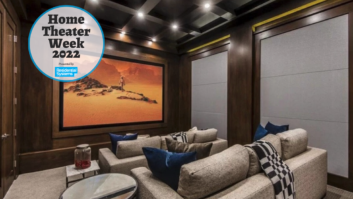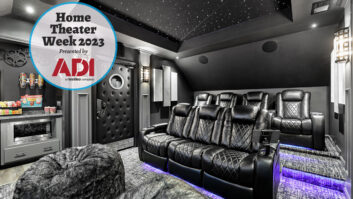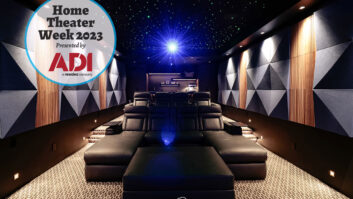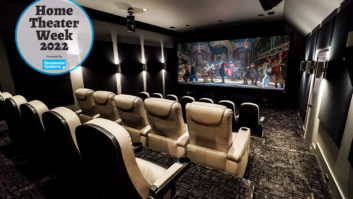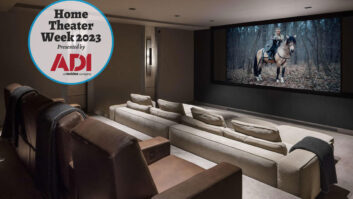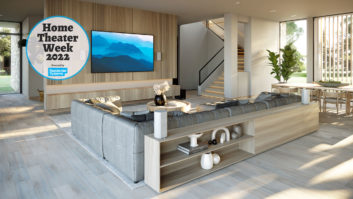It’s rare that I feel compelled to use the oft-overhyped label “legend,” but someone like Theo Kalomirakis surely deserves the title.
The legendary home theater designer, often called the father of home theater, recently opened up his Brooklyn home to celebrate his new theater concept, dubbed Roxy 2.0.
The concept of Roxy 2.0 is to bring together the ease and convenience consumers today desire with the high quality, immersive experience that is unrivaled by a dedicated home theater space.
Brands participating in this project include Kaleidescape, Digital Projection, Stewart Filmscreen, California Audio Technologies (CAT), SH Acoustics, Crestron, and Prima Cinema.

Jeff Schneider, Northeast sales manager for DPI, admires the rack for Theo Kalomirakis’ home theater room, Roxy 2.0.
As Theo was busy entertaining his guests most of the night, Brian Barr, president, CEO, and co-founder of CAT, gave me a demo of the system. Barr not only detailed the impressive audio solution his company provided, but also some insight into Theo’s process and why it’s so important to the industry.
“The purpose of this room is to show how, especially in the [New York City] environment, something as small as this room can still be extraordinary,” he started off with.
The speakers total 24 in the modestly sized room (there are just six theatre seats), but they were custom built to be shallow enough to fit into the walls. Each speaker was built one at a time. “Everything is designed on a computer custom. The shape is chosen, even the parts that move, the drivers, they’re all built one at a time.”
Three full speakers were placed behind the Stewart Filmscreen’s curved, perforated screen with four subwoofers in the front. “And those four work in unison, so they don’t have to move that far,” he said, explaining the difference there is in bass sounds that an average subwoofer demonstrates. Building multiple subs allows them to not have to work as hard to put a uniform wave out into the room. Four additional subwoofers are strategically located to do cancellation. “Kind of like what you do in a noise cancellation headphone, but in this whole room environment.”
The front wave goes out past the people seated while the side subs go the opposite direction to cancel the fronts out, “and you never have to hear it twice,” he said. “So that makes things much faster, much more accurate, make it much more realistic. I can turn it up louder, and you can hear details of people whispering and kissing and speaking—and not have the hearing fatigue you’d normally have.”
Everything down to the fabrics used in the speakers were custom chosen by Theo. CAT also provided three amplifiers for the room. Barr estimated that there were $300,000 to $400,000 in CAT products alone in what he conjectured is a three quarter to a million dollar room.
At this point, Barr went on to tout the team effort this type of installation requires—a team Theo hand selects.
“What people need to understand about home theater, it should finally perform with the reliability, and the design, and the functionality of a car.”
The example Barr used was that of a Ferrari, where all the pieces work together at the completion, even though Ferrari outsources certain parts, like the glass windows. “It’s critical to involve an integration company that can put this together, a designer like Theo, the people who really work together because otherwise, the wrong seats or the wrong space, and you’re not going to have a good environment. The wrong fabrics can muffle the sound. The wrong screen can block the speakers.”
And of course, the demo spoke for itself.
